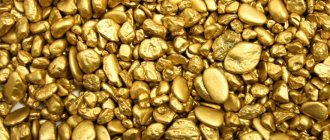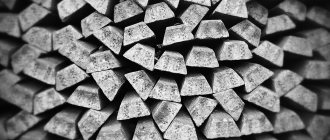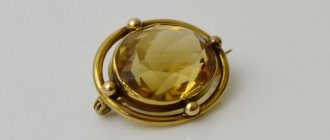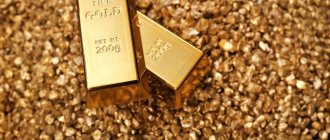The unique chemical properties of gold have given it a special place among the metals used on Earth. Gold has been known to mankind since ancient times. Since ancient times it has been used as jewelry; alchemists tried to extract the precious metal from other less noble substances. Currently, the demand for it is only growing. It is used in industry, medicine, and technology. In addition, it is acquired by both states and private individuals, using it as an investment metal.
Use of precious metal in various industries
The main industries in which this metal is widely used are:
- jewelry industry;
- creation of modern electrical appliances;
- optics;
- medicine;
- cooking;
- atomic research;
- production of weapons of mass destruction.
Only a tenth of the extracted noble element goes into industry, about 45% ends up in the gold and foreign exchange reserves of states and private individuals. The rest of the metal is used to make jewelry.
Areas of application
Gold has long been used by various countries in the form of coins. However, they were approved as a monopoly monetary instrument only in the 19th century.
Today, the precious metal is used in many areas of society:
- Jewelry industry. It is this area that accounts for a large volume of mined rock. Jewelry and accessories are made not from pure substance, but from its alloys with other metals, which increase the mechanical strength and durability of the products. Usually gold is combined with silver and copper. Additional components include zinc, cobalt, nickel or palladium. The precious metal determines the resistance of the alloy to corrosion, the ratio of copper and silver determines the shade and mechanical features. An important characteristic of such products is sample. It is determined by the gold content in them.
- Industry. The substance is used for electrical contacts. Microelectronics cannot do without gold conductors and electroplated metal coatings. Treating window glass with this material can reduce heat loss in winter and protect rooms from heating by ultraviolet rays in summer. Gold solders are used to moisten surfaces of various metals. The substance is used to protect against corrosion and give other materials an expensive look.
- Dentistry. Gold alloys are used to produce crowns and dentures that do not deteriorate.
- Pharmacology. The substance often serves as an additional component in medications for tuberculosis and rheumatoid arthritis. The radioactive isotope, designated 198Au, is used to treat malignant tumors. Before using drugs, you need to make sure that the patient does not have negative reactions to gold.
- Food industry. The element as a food additive E175 is used to decorate various dishes.
At all times, gold has served as an important element of the financial system. This metal is not susceptible to corrosion, so they are trying to find application in various fields. The metal's role as an international currency has periodically declined, but banks in all countries hold it as the most important source of liquidity.
History of the development of gold-bearing veins
Archaeologists suggest that gold mining as a branch of the national economy originated in the Middle East. From there, jewelry was exported to Egypt. The first finds in Sumerian tombs are more than 3 thousand years old.
One of the richest cultures in gold reserves was the ancient Inca Empire, which was located in the territory of modern Mexico, Peru and Chile. Their legacy is the mythical golden city of Eldorado, in search of which the Spanish conquistadors went.
In the 15th century, the first deposits were discovered in Mexico, Chile and Ghana. Three centuries later, the first gold mining cooperatives appeared in Russia. In 1823, the richest veins were discovered in Canada and America, which was marked by the outbreak of the famous “gold rush”. Even later, deposits were discovered in South Africa and Australia.
Receipt
Gold nugget
To obtain gold, its basic physical and chemical properties are used: its presence in nature in a native state, the ability to react with only a few substances (mercury, cyanide). With the development of modern technologies, chemical methods are becoming more popular.
Flushing
The washing method is based on the high density of gold, due to which, in a stream of water, minerals with a density less than gold (and these are almost all minerals of the earth’s crust) are washed away and the metal is concentrated in a heavy fraction, sand consisting of minerals of high density, which is called concentrate. This process is called concentrate washing or grinding. In small volumes it can be done manually using a washing tray. This method has been used since ancient times, and is still used to develop small placer deposits by prospectors, but its main application is to search for deposits of gold, diamonds and other valuable metals.
Flushing is used to develop large placer deposits, but special technical devices are used: dredges and flushing devices. The resulting concentrates, in addition to gold, contain many other dense minerals and the metal is extracted from them, for example, by amalgamation.
All placer gold deposits are developed using the washing method; it is used to a limited extent in primary deposits. To do this, the rock is crushed and then washed. This method cannot be applied to deposits with dispersed gold, where it is so dispersed in the rock that after crushing it does not separate into individual grains and is washed away during washing along with other minerals. Unfortunately, during washing, not only small gold is lost, which is easily washed off from the washing block, but also large nuggets, the hydraulic coarseness of which does not allow them to settle quietly in the cells of the mat. Therefore, on dredges and industrial equipment, be sure to keep an eye out for large rolling debris - these could very well turn out to be nuggets!
This method of extracting gold was historically the first, and it is very cheap because it does not require the construction of expensive factories, and in the case of river sediments, there is no need to crush the rock. It is economically profitable to mine placers with a gold content of more than 0.1 g per 1 cubic meter of loose rock (sand, loam, etc.).
Amalgamation
The amalgamation method is based on the ability of mercury to form alloys - amalgams with various metals, including gold. In this method, moistened crushed rock was mixed with mercury and subjected to additional grinding in mills - running bowls. The amalgam of gold (and associated metals) was removed from the resulting sludge by washing, after which the mercury was distilled from the collected amalgam and reused. The amalgamation method has been known since the 1st century BC. e., acquired the greatest scale in the American colonies of Spain starting from the 16th century: this became possible due to the presence in Spain of a huge mercury deposit - Almaden. At a later time, the method of external amalgamation was used, when crushed gold-bearing rock, during washing, was passed through enrichment sluices lined with copper sheets coated with a thin layer of mercury. The amalgamation method is applicable only in deposits with a high gold content or during its enrichment. It is now used very rarely, mainly by prospectors in Africa and South America.
Cyanidation
Gold dissolves in solutions of hydrocyanic acid and its salts, and this property has given rise to a number of extraction methods by cyanidation of ores.
The cyanidation method is based on the reaction of gold with cyanides in the presence of atmospheric oxygen: crushed gold-bearing rock is treated with a dilute (0.3-0.03%) solution of sodium cyanide, gold from the resulting solution of sodium cyanoaurate Na[Au(CN)2]
deposited either with zinc dust or on special ion exchange resins.
The cyanidation method was initially used in large factories, where the rock was crushed and cyanidation was carried out in special vats. However, the development of technology has led to the emergence of the heap leaching method, which consists of the following: a waterproof platform is prepared, ore is poured onto it and it is irrigated with cyanide solutions, which, seeping through the rock, dissolve the gold. After this, they enter special sorption columns, in which the gold is deposited, and the regenerated solution is sent back to the heap.
The cyanidation method is limited by the mineral composition of the ores; it is not applicable if the ore contains large amounts of sulfides or arsenides, since cyanides react with these minerals. Therefore, cyanidation processes low-sulfide ores or ores from an oxidation zone in which sulfides and arsenides are oxidized by atmospheric oxygen.
Complex multi-stage technologies are used to extract gold from sulfide ores. Gold extracted from deposits contains various impurities, so it is subjected to special highly purified processes that are carried out in refineries.
Regeneration
It is carried out by the action of a 10% alkali solution on solutions of gold salts, followed by the precipitation of refined gold onto aluminum from a hot hydroxide solution.
Famous gold deposits
An interesting fact is that 90% of all gold production in the world is provided by the ten largest deposits. The richest and most famous include:
- Muruntau, Uzbekistan. According to preliminary estimates, it is 2.5 times more promising than the next field on the list.
- Grassberg, Indonesia.
- Pueblo Viejo, Dominican Republic.
- Yanacocha in the Cajamarca region, Peru.
- Carlin Trend, Nevada, USA.
- Goldstrike mine, which includes 3 deposits, USA.
- Cortez, Nevada, USA.
- Olympics in Russia, Krasnoyarsk region.
- Veladero mine in Argentina.
- Boddington Quarry, Australia.
PROPERTIES
Gold bars and nuggets
Gold is a very heavy metal: the density of pure gold is 19.32 g/cm³ (a ball of pure gold with a diameter of 46.237 mm has a mass of 1 kg). Diamagnetic, that is, the magnetic field in gold weakens. Among metals, it ranks seventh in density after osmium, iridium, rhenium, platinum, neptunium and plutonium. Tungsten has a density comparable to gold (19.25). The high density of gold makes it easier to extract, which is why even simple technological processes - for example, washing at sluices - can provide a high degree of gold recovery from the washed rock. Gold is a very soft metal: hardness on the Mohs scale is ~2.5, on the Brinell scale 220-250 MPa (comparable to the hardness of a fingernail). Gold is also highly ductile: it can be forged into sheets up to ~0.1 µm (100 nm) thick (gold leaf); With such a thickness, gold is translucent and in reflected light has a yellow color, in transmitted light it is colored bluish-greenish, complementary to yellow. Gold can be drawn into wire with a linear density of up to 2 mg/m. The melting point of gold is 1064.18 °C (1337.33 K), boils at 2856 °C (3129 K). The density of liquid gold is less than solid gold and is 17 g/cm3 at the melting point. Liquid gold is quite volatile and actively evaporates long before its boiling point.
Profitability and laws
Gold mining on an industrial scale can only be carried out if the deposit is profitable - at least 3 g per ton of ore. If a mine cannot provide this level of metal production, it is recognized as unprofitable, and work on it is stopped.
Until 2021, individuals were prohibited from mining metal even in depleted deposits. Violation of the law entailed punishment including criminal liability. However, the law has been revised, and now gold mining can be carried out by a private individual who has registered an individual entrepreneur.
Extraction of valuable metal is subject to licensing by the Rosnedra organization. Before obtaining permission, the applicant will have to win this right at an auction, and the cost of such a license amounts to billions of rubles if we are talking about promising deposits.
Without obtaining a special permit, you can mine precious metal by concluding a contract with a gold mining organization to carry out work on its territory.
Profit today and prospects for the future
Gold is a measure of the well-being of entire states. As an investment object, it shows a steady increase in value year after year, which makes it an excellent source of investment. According to experts, this trend will continue in the coming years.
Chemical features
Gold has several oxidation states: +1, +3, -1. The +5 indicator appears with fluorine, the compound with which acts as a strong oxidizing agent.
Because the element is relatively inert, it usually does not dissolve in acids. Therefore, it can be purified from impurities with these compounds. However, there are a few exceptions: gold can dissolve in selenic and hydrocyanic acids, cyanides, and also in aqua regia.
Under natural conditions, metal does not oxidize under the influence of oxygen. This is one of the reasons why it is considered precious. At high temperatures, the substance interacts with halogens (iodine, bromine and chlorine).
The most stable oxidation state is +3. With singly charged anions, gold forms planar-square complexes. The +1 oxidation state is considered relatively stable. The +2 indicator is usually expressed formally, but with it, half of the metal in the substance is oxidized to +1, and the other to +3. In aurides, the oxidation state of Au is -1.
Gold can react with perchloric acid at room temperature to form unstable chlorine oxides; it interacts with oxygen and other oxidizing agents as complexing agents: dissolving in cyanides, the element forms cyanoaurates.









